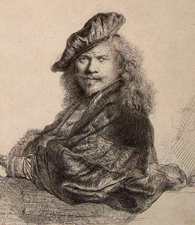Arguably the most famous Dutch artist of the 17th century, Rembrandt van Rijn possessed a multitude of artistic talents, but is particularly well-known for the masterful use of light and shade in his work.
Rembrandt’s Early Years
Rembrandt Harmenszoon van Rijn was born on July 15, 1606, to a modest family that did not belong to the artistic world. His father, Harmen, worked as a miller, and his mother, Neeltgen, came from a family of bakers.
In his early years, Rembrandt was primarily a portrait artist, but he eventually tackled other subject matters and expanded the scope of his work. A fair portion of his work deals with biblical stories and characters, portrayed realistically rather than idealistically. His unfailing commitment to realism has led some critics to accuse him of favoring ugliness over beauty in his work, explains Ernst van de Wetering, author of “Rembrandt: The Painter at Work.”
Sources in this Story
- Encyclopedia Britannica: Rembrandt van Rijn
- The Metropolitan Museum of Art: Rembrandt van Rijn (1606-1669): Paintings
- Rijksmuseum: The Night Watch
- Carnegie Magazine: Rembrandt
- The National Gallery: Rembrandt
- Rembrandt van Rijn: Life and Work: Rembrandt Museums
- National Gallery of Art: Rembrandt van Rijn: The Artist
- Newser (AP): ‘Fake’ Rembrandt a Real $40M Self-Portrait
Rembrandt’s Art
According to The Metropolitan Museum of Art, a Mennonite influence likely explains Rembrandt’s use of biblical subjects in his paintings. The Mennonite art dealer Hendrick Uylenburgh assisted Rembrandt in securing commissions, and Rembrandt married Hendricks’ cousin Saskia in 1634.
By the 1640s, though, his artistic style evolved from “theatrical” to “more contemplative,” probably due to the death of his wife. During this period, Rembrandt painted the group portrait entitled “The Night Watch,” which marked the end of his “most successful years,” Walter Liedtke wrote for The Metropolitan Museum of Art.
“The Night Watch” may have signaled the end of an era for Rembrandt, but it is one of his most famous works and a signature display of his use of light and darkness. According to the Rijksmuseum, the scene in the painting depicts a group of militiamen mobilizing for action. Night is falling on the troops, and the remaining light focuses on the two most important people in the group: the captain and the lieutenant.
Although many people know Rembrandt as a painter, his etchings were the driving force behind his international recognition as an artist. Etchings are made by drawing on a resin-coated plate with a needle, explains Kahren Jones Arbitman, executive director of The Cummer Museum of Art & Gardens. The plate is then submerged in acid, which “etches” the drawing into the plate. From there, the plates are dipped in ink to make a print on paper.
Rembrandt was unique both in his ability to create a beautiful etching and in the fact that he seldom had a printmaker create prints of his work, preferring to make them himself, according to the National Gallery in London.
Today, dozens of Rembrandt’s paintings are enjoyed by viewers in museums around the world. Find a comprehensive list of the locations of some of his works, together with images, courtesy of the web site, Rembrandt van Rijn: Life and Work.
The Man and His Work
- “The Complete Etchings of Rembrandt”
- “Rembrandt Drawings: 116 Masterpieces in Original Color”
- “Rembrandt’s Journey: Painter, Draftsman, Etcher,” by Thomas Rassieur, William Robinson, Clifford Ackley and Ronni Baer
- “Rembrandt: The Painter at Work,” by Ernst van de Wetering
- “Rembrandt’s Nose: Of Flesh and Spirit in the Master’s Portraits,” by Michael Taylor
The Rest of the Story
Rembrandt died on October 4, 1669. He was preceded in death by his four children and his wife, Saskia.
In 2008, art experts confirmed that a portrait of Rembrandt, once dismissed as a “knockoff,” is, in fact, an original self-portrait that Rembrandt painted around 1628. A British buyer purchased the portrait for $4.5 million from an auction house in 2007, but experts say the piece is worth $40 million.
This article was originally written by Lindsey Chapman; it was updated June 2, 2017.











